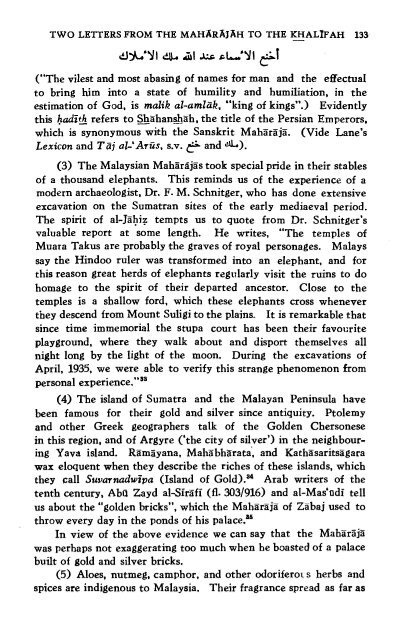TWO LETTERS FROM THE MAHARAJA TO THE KHALIFAH
TWO LETTERS FROM THE MAHARAJA TO THE KHALIFAH
TWO LETTERS FROM THE MAHARAJA TO THE KHALIFAH
You also want an ePaper? Increase the reach of your titles
YUMPU automatically turns print PDFs into web optimized ePapers that Google loves.
<strong>TWO</strong> <strong>LETTERS</strong> <strong>FROM</strong> <strong>THE</strong> <strong>MAHARAJA</strong>H <strong>TO</strong> <strong>THE</strong> KHAL~FAH - 133<br />
("The vilest and most abasing of names for man and the effectual<br />
to bring him into a state of humility and humiliation, in the<br />
estimation of God, is malik al-amliik, "king of kings".) Evidently<br />
this hadith refers to &ahanshah, the title of the Persian Emperors,<br />
which is synonymous with the Sanskrit Maharaja. (Vide Lane's<br />
Lexicon and Ttij aL'Ariis, S.V. and 4).<br />
(3) The Malaysian MahHrfijas took special pride in their stables<br />
of a thousand elephants. This reminds us of the experience of a<br />
modern archaeologist, Dr. F. M. Schnitger, who has done extensive<br />
excavation on the Sumatran sites of the early mediaeval period.<br />
The spirit of al-J~hi? tempts us to quote from Dr. Schnitger's<br />
valuable report at some length. He writes, "The temples of<br />
Muara Takus are probably the graves of royal personages. Malays<br />
say the Hindoo ruler was transformed into an elephant, and for<br />
this reason great herds of elephants regularly visit the ruins to do<br />
homage to the spirit of their departed ancestor. Close to the<br />
temples is a shallow ford, which these elephants cross whenever<br />
they descend from Mount Suligi to the plains. It is remarkable that<br />
since time immemorial the stupa court has been their favourite<br />
playground, where they walk about and disport themselves all<br />
night long by the light of the moon. During the excavations of<br />
April, 1935, we were able to verify this strange phenomenon from<br />
personal experience.<br />
(4) The island of Sumatra and the Malayan Peninsula have<br />
been famous for their gold and silver since antiquity. Ptolemy<br />
and other Greek geographers talk of the Golden Chersonese<br />
in this region, and of Argyre ('the city of silver') in the neighbouring<br />
Yava island. Ramiiyana, ~ahabharata, and KathHsaritsHgara<br />
wax eloquent when they describe the riches of these islands, which<br />
they call Suvarnadwipa (Island of G~ld).~ Arab writers of the<br />
tenth century, Abti Zayd al-Sirsfi (fl. 3031916) and al-Mas'adi tell<br />
us about the "golden bricks", which the Mahsrajg of Zabaj used to<br />
throw every day in the ponds of his palace?'<br />
In view of the above evidence we can say that the Mah~r~j~<br />
was perhaps not exaggerating too much when be boasted of a palace<br />
built of gold and silver bricks.<br />
(5) Aloes, nutmeg, camphor, and other odorifero~ s herbs and<br />
spices are indigenous to Malaysia. Their fragrance spread as far as
















